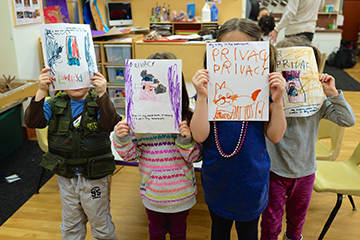What Does Privacy Look Like? Carnegie Mellon Professor Explores Public Attitudes, Concerns Using Drawings Hundreds of People Draw Pictures Expressing Ideas About Privacy
Daniel Tkacik, Byron SpiceThursday, January 15, 2015Print this page.

What is privacy? People sometimes have a hard time putting it into words. So Lorrie Cranor, a leading authority on Internet privacy at Carnegie Mellon University, has explored the meaning of privacy by asking people to draw pictures.
The project, Privacy Illustrated, has amassed hundreds of drawings thus far, from participants ranging in age from 5 to 91. And Cranor invites anyone to contribute to the project by making a drawing of what privacy means to them and uploading it to the project website.
"It's a fascinating view into what people think about privacy," said Cranor, a professor of computer science and engineering and public policy, as well as director of the CyLab Usable Privacy and Security Lab.
"With the little kids, you can see doors, bedrooms and pulling the blankets over their heads," as concerns about their bodies and personal spaces predominate, she said. She noted that adults and teens express some of the same concerns but, in this post-Snowden era, also reveal worries about government surveillance or overexposure on social networks.
"Though some talk about privacy as being an old-fashioned idea, these pictures show that people of all ages do care about privacy," Cranor said.
Cranor's project began at Carnegie Mellon's Studio for Creative Inquiry, where she and a group of artists, Ph.D. students and postdocs collaborated on a project called Deep Lab, which examined themes including not only privacy, but also security, anonymity and large-scale data aggregation. The project produced a 240-page book, available in print or as a free download, and Privacy Illustrated was one of the chapters.
Cranor and her colleagues visited the Carnegie Mellon Children's School and Pittsburgh Public School classrooms to collect drawings from students in kindergarten, third grade, sixth grade and high school. For adults, Cranor's group initially crowdsourced the drawings by hiring online workers through Amazon Mechanical Turk to produce more than 100 pictures.
She continues to collect drawings at conferences and from volunteers who upload their own drawings. People can draw a picture and then photograph it or scan it so it can be uploaded, or they can use a tablet or other digital device to draw the picture and then upload it. The Privacy Illustrated team will have markers and paper available at CMU's Privacy Day celebration on Jan. 28, and will be collecting privacy drawings.
Visitors to the Privacy Illustrated website can explore the drawings in random order or via keywords.
Byron Spice | 412-268-9068 | bspice@cs.cmu.edu
